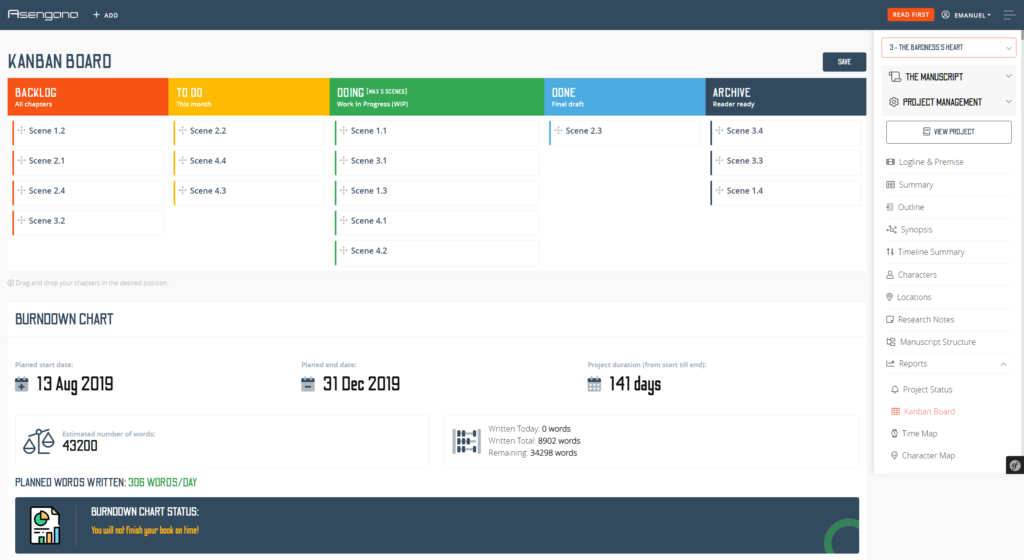Project Management for writers – Kanban
or
One day at a time
Project management is not exclusively useful to companies. Any human activity can be defined as a project as long as it has a specific goal, a time frame, a minimum expected quality, and fits into a pre-defined budget.
 In other words a writer’s project can be: write a book in 6 months, have it approved/improved by an editor and promoted by a literary agent or self-published, within a budget of $4000.
In other words a writer’s project can be: write a book in 6 months, have it approved/improved by an editor and promoted by a literary agent or self-published, within a budget of $4000.
Kanban is an Agile methodology I use in my everyday life. You will be using it when writing your books with the assistance of the Asengana platform.
Like any project management methodology, Kanban (there is so much information about Kanban online it wouldn’t fit in one article) is just a tool. It will not do your work for you, but it might help you transition to a more efficient writing style.
Here is what Kanban can do for you:
- Teach you how to do things right the first time.
- Help you be better at decision making, especially when you are overwhelmed with assignments, all at the same time.
- Give you a comprehensive overview of the task you plan to perform, are performing, or you performed.
- Assist you in a fast-paced transformation of your vision into reality.
The secret of Kanban, compared with other project management methodologies, is simple:
You don’t set a time limit. You set a limit for how much work you do.
It doesn’t mean you shouldn’t set a deadline for your draft. It means that you decide very day how much you want to do and stick with it.
So, what is Kanban about?
You take things one day at a time. Although it sounds counterintuitive, having no time restrictions helps you accomplish your goals faster. You just decide on the list of things you want to carry out every day and work on it with a twist.
The steps you need to follow are:
- Set the path for your idea from concept to a functional product.
- Set a Kanban Board with vertical columns. The minimal one has 5 columns: Backlog, To Do, Doing, Done, Archive. There are more complicated models, but this will do for now.
- Create the activity blocks. If you use a wall for your Kanban Board, you can use post its and write down these activity blocks. Each one can be a task or idea, or just parts of it. If, for example, you decide that an activity should be building your website, you can split it into blocks: buy domain, buy hosting, install WordPress, create pages, and so on. Ideally, the blocks should represent a task that can be done in less than a day.
- The twist: Set your own limit for the number of tasks you want to fulfill every day and every week/month. We call this WIP (Work in Progress). Usually the WIP doesn’t go above 3 (for Asengana we used 5 – 5 scenes/ aprox 900 each – this is close the upper limit for how much you can write in a day).

The workflow for these tasks:
- At first, all of them go into the Backlog column.
- Once you decide on the tasks to be worked upon on a certain day/week, move them into the To Do column.
- Every morning move the blocks/sub-tasks corresponding to your WIP limit (3) into the Doing column. Important: you work on those and only those activities that day, except for an emergency.
- Once you conclude an activity, move the block into the Done column.
- When you complete (Done) all sub-tasks/blocks for an activity move them to Archive.
![]() The beautiful thing about Kanban is that it follows the flow of accomplishing any task in real life, while helping you better organize your professional life. It eliminates the artificial pressure of deadlines, empowering you to carry out as much as you can in as much time as necessary.
The beautiful thing about Kanban is that it follows the flow of accomplishing any task in real life, while helping you better organize your professional life. It eliminates the artificial pressure of deadlines, empowering you to carry out as much as you can in as much time as necessary.
In time, you will realize that you can attain everything you had planned for faster than you used to.
You can also measure the amount of time needed to accomplish every task. In this way, you will get better at making decisions about:
- Strategies to shorten the time period allocated for a certain activity, and
- Either to start working on an activity or not; maybe you decide that one of the tasks in the Backlog is not worth accomplishing at all.
I recommend using a Kanban methodology for both your personal and professional life.
As for writing, you will have to use Asengana to understand how we adapted Kanban so that one can better organize your writing projects. You’ll discover a tool that increases your productivity and offers you valuable insights into your writing process.
You should also read:
SMM 1/7 – Why is the way you define Social Media Marketing important?
SMM 2/7 – Personal branding for writers
SMM 3/7 – The website – a writer’s castle
SMM 4/7 – The story about you writing your story
SMM 5/7 – Social Networks – a like value is 0
SMM 6/7 – DIY Social Media Marketing Plan for writers




